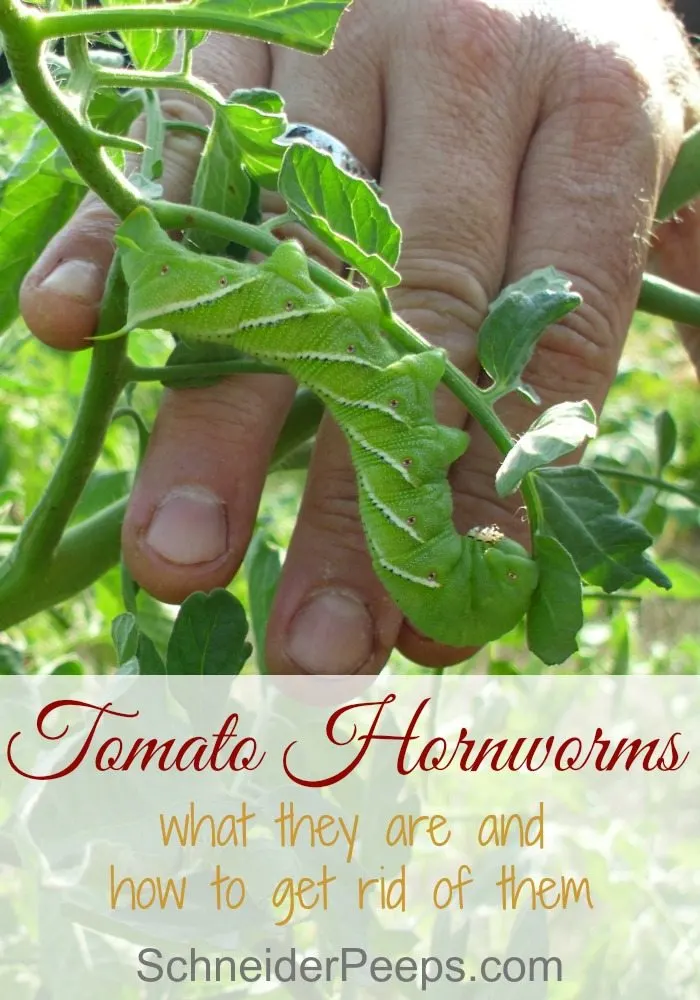
This weekend we discovered tomato hornworms in our garden. Can you see it? Carl had to show me several times before I could figure out what he was showing me.
 This is how he knew something was up…leaves totally stripped from the top of a very healthy tomato plant.
This is how he knew something was up…leaves totally stripped from the top of a very healthy tomato plant.
So now, each evening we have a garden “date” in which we look for these guys.
Want to know more about the tomato hornworm?
The tomato hornworm and the tobacco hornworm are very similar and both eat tomatoes, tobacco, eggplant and peppers. Both are big…3-4 inches long. Both become a type of sphinx moth which are about the size of a humming bird so they are sometimes call hummingbird moths. Tomato horn worms have “v” shaped marks and a black horn on its rear end. Tobacco horn worms have diagonal white stripes and a red horn on its rear end. Tomato horn worms are usually in the north and tobacco horn worms are usually in the south.
Life cycle of a hornworm:
-
The good news is that there is only one life cycle per season, unlike the vine borer.
-
The bad news is that the moths overwinter in the soil as dark brown pupae, so you will probably deal with them year after year.
-
They emerge and mate in late spring
-
They lay their eggs, which are round and greenish-white, on the undersides of leaves.
-
The eggs hatch in four to five days, and the hornworm emerges. It spends the next four weeks growing to full size.
-
Then it digs its way into the ground for the winter.
Prevention:
-
You’ll probably notice the effects of the hornworm before the hornworm itself – so a daily walk through your garden is beneficial.
-
Since they are large the best way of getting rid of them is to just pick them off. You can then either squish them, feed them to the chickens (our preferred method) or put them in a jar, feed them and watch them become a moth (we might do this…once)
-
If the infestation is large you could use some bt (also known as Dipel Dust) to help get rid of them.
-
Parasitic wasps are great! If you see a hornworm with little white eggs or grubs on them don’t kill it. Those are parasitic wasps and they will really be helpful in your garden. (This is why it’s important not to use insecticides on your garden) If you don’t want them you can send them my way.
-
If you notice that you have a problem year after year and you don’t already till, try tilling your garden a couple of times before spring planting to destroy the pupae.
How do you keep the pests down in your garden?

You can find information about other fruits and veggies by searching clicking on the In The Garden tab up top or in The Gardening Notebook.

Angel
Friday 1st of March 2024
I’m not usually squeamish in the garden but when I suddenly had a tomato plant’s leaves eaten in about a day I knew we had an issue. When I finally saw this monster I screamed. I cannot express how much I hate grabbing these things. They hold on to the plant, and it’s actually a bit of a fight to get them off! Usually I would see some sort of thing like this and kill it with my snips, no problem, but these things are meaty! I love the idea of feeding them to my neighbors chickens. They eat my tomato guts after I process them, and love it. A disgusting hornworm will make them extra happy. I did have plenty of other caterpillars in my tomato plants that were more brown like but they also eat the leaves and the tomatoes as well.
Angi Schneider
Friday 1st of March 2024
Goodness, you're a good storyteller. You had me giggling!
Gina
Monday 3rd of October 2016
There was one on a tomato plant in my garden this year.. A big one too! I thought he was a cute caterpillar. I took pictures of him lol ? I've only seen two or three in my life, so I didn't know they specifically liked tomato plants.
Angi Schneider
Monday 3rd of October 2016
lol...he is a cute caterpillar. And makes a beautiful moth. I've been known to just "relocate" them every once in a while instead of giving them to the chickens. It's such a hard balance.
Jami @ An Oregon Cottage
Monday 25th of June 2012
Agggh! Luckily, I've only dealt with hornworms once, and a few pickings removed them. Wish I had chickens to feed them to... ;-)
Beth
Wednesday 20th of June 2012
Thank goodness we don't have those - how about some chickens to help with the pests?
SchneiderPeeps
Wednesday 20th of June 2012
Our chickens do help. Right now we're picking the worms off and giving them to the chickens. But after we harvest this section we're going to put the chickens in the garden to scratch and peck the soil. Hopefully that will help for next year.
Mrs. Petrie
Tuesday 19th of June 2012
That was a huge hornworm!! We get them too, but I have my kids go through the plants and dispose of them, haha. :)
SchneiderPeeps
Wednesday 20th of June 2012
I know. It's funny because even though it's so huge I had trouble seeing it at first.